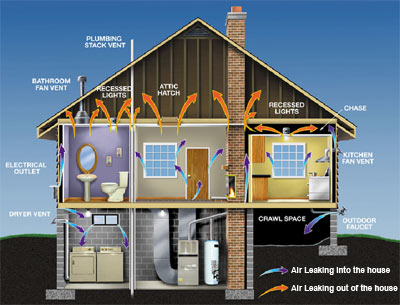Sealing Air Leaks
 Many air leaks and drafts are easy to find because they’re easy to feel, e.g., around windows and doors. But holes hidden in attics, basements, and crawlspaces can be especially troublesome. Sealing these leaks with caulk, spray foam, or weather stripping will have a great impact on improving your comfort and reducing utility bills.
Many air leaks and drafts are easy to find because they’re easy to feel, e.g., around windows and doors. But holes hidden in attics, basements, and crawlspaces can be especially troublesome. Sealing these leaks with caulk, spray foam, or weather stripping will have a great impact on improving your comfort and reducing utility bills.
Homeowners are often concerned about sealing their home too tightly; however, this is unlikely in most older homes. If your home is too tight, a fresh air ventilation system may be necessary. Fresh air is necessary for good indoor air quality and there are specifications that set the minimum amount of fresh air needed for a house. However, it’s unwise to rely on air leakage for ventilation because it can’t be controlled. During cold or windy weather, too much air may enter the house. When it’s warmer and less windy, not enough air may enter. Air infiltration also can contribute to problems with moisture control. Moldy and dusty air can enter a leaky house through such areas as attics or foundations and cause health problems. The recommended strategy in both new and old homes is to reduce air leakage as much as possible and to provide controlled ventilation as needed. Note: air sealing alone can’t replace the need for proper insulation throughout your home, which is needed to reduce heat flow.
Source Material: US Dept. of Energy










